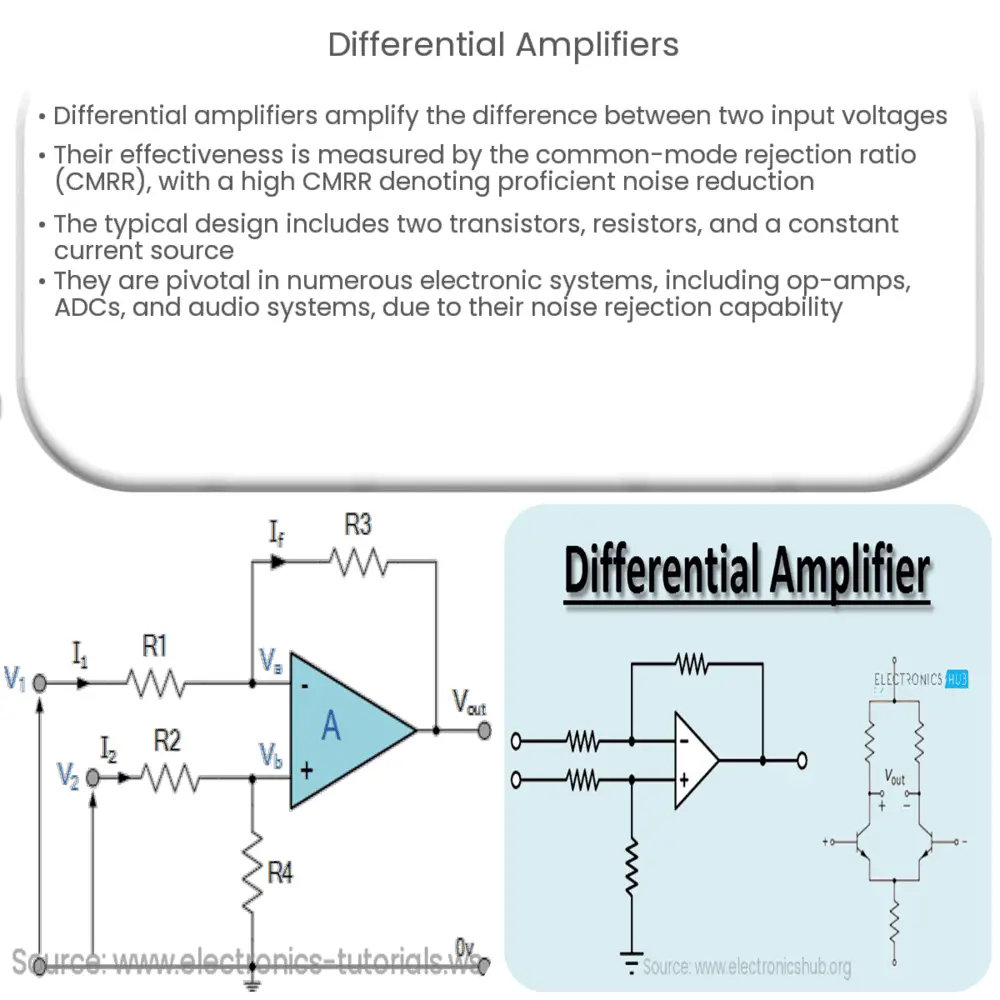Explore the workings, circuit design, and applications of differential amplifiers, vital components in modern electronics.

Introduction to Differential Amplifiers
A differential amplifier, as its name suggests, is a type of electronic amplifier that amplifies the difference between two input voltages. It has two inputs, often referred to as the ‘inverting’ and ‘non-inverting’ inputs, and one output. The main characteristic of a differential amplifier is that it multiplies the difference between the signals applied to its inputs. This characteristic makes differential amplifiers extremely useful in a variety of applications, including noise reduction, and they are key components in many electronic devices and systems.
Working Principle of Differential Amplifiers
The core working principle of a differential amplifier lies in its unique ability to amplify the voltage difference between its inputs while rejecting any voltages that are common to both. This particular feature is often described as the ‘common-mode rejection ratio’ (CMRR).
- CMRR: A differential amplifier’s effectiveness is often gauged by its CMRR. A high CMRR indicates that the amplifier is proficient at amplifying the differential signal while rejecting the common-mode signal. Thus, differential amplifiers with a high CMRR are particularly beneficial in situations where signal quality is crucial, and noise reduction is of paramount importance.
Let’s dive a little deeper into the circuit design of differential amplifiers.
Circuit Design of Differential Amplifiers
While the specific layout of a differential amplifier can vary based on its application and required performance characteristics, the general design remains consistent. It typically consists of two transistors (either BJTs or MOSFETs), a few resistors, and a constant current source.
- The emitter terminals of the two transistors are connected together and to the constant current source. The base terminals of the transistors serve as the inverting and non-inverting inputs. The collector terminals act as outputs.
- Resistors are typically connected to each collector terminal. They help in determining the gain of the amplifier, which is a measure of how much the input signal is amplified.
This design enables the differential amplifier to accurately amplify the difference between its two inputs while disregarding signals common to both.
To understand better, let’s explore the mathematical description of differential amplifiers in the next section.
Mathematical Description of Differential Amplifiers
The mathematical model of a differential amplifier can be represented by the following equation:
Vout = Ad (V2 – V1)
- In the equation above, Vout represents the output voltage, while V1 and V2 are the voltages at the inverting and non-inverting inputs, respectively. Ad, on the other hand, signifies the differential gain of the amplifier.
This equation elegantly illustrates the differential amplifier’s primary function – to amplify the voltage difference between its inputs. It also shows that the output is directly proportional to the difference in input voltages.
Applications of Differential Amplifiers
Differential amplifiers are vital in numerous electronic systems and devices, including but not limited to:
- Operational Amplifiers (Op-Amps): Most operational amplifiers employ a differential input stage, enhancing their performance by offering high input impedance and common-mode noise rejection.
- Analog-to-Digital Converters (ADCs): Differential amplifiers are crucial in the design of ADCs. They help in eliminating noise and other common-mode signals before the analog signal is converted into a digital one.
- Audio Systems: These systems often utilize differential amplifiers to minimize noise interference and maintain high-quality sound reproduction.
Conclusion
In conclusion, differential amplifiers play a fundamental role in modern electronics. Their unique ability to amplify the difference in input voltages while rejecting common-mode signals makes them essential components in a multitude of electronic systems and devices, from op-amps and ADCs to audio systems and more. Understanding their working principle, circuit design, and mathematical description is crucial for anyone looking to delve deeper into the realm of electronics. As technology advances, differential amplifiers will continue to evolve, presenting even more fascinating opportunities for innovation and application.

